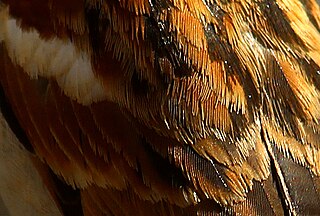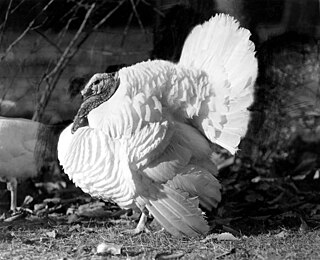Related Research Articles

The domestic turkey is a large fowl, one of the two species in the genus Meleagris and the same species as the wild turkey. Although turkey domestication was thought to have occurred in central Mesoamerica at least 2,000 years ago, recent research suggests a possible second domestication event in the area that is now the southwestern United States between 200 BC and 500 AD. However, all of the main domestic turkey varieties today descend from the turkey raised in central Mexico that was subsequently imported into Europe by the Spanish in the 16th century.

The ocellated turkey is a species of turkey residing primarily in the Yucatán Peninsula, Mexico, as well as in parts of Belize and Guatemala. A relative of the North American wild turkey, it was sometimes previously considered in a genus of its own (Agriocharis), but the differences between the two turkeys are currently considered too small to justify generic segregation. It is a relatively large bird, at around 70–122 cm (28–48 in) long and an average weight of 3 kg (6.6 lb) in females and 5 kg (11 lb) in males.

Plumage is a layer of feathers that covers a bird and the pattern, colour, and arrangement of those feathers. The pattern and colours of plumage differ between species and subspecies and may vary with age classes. Within species, there can be different colour morphs. The placement of feathers on a bird is not haphazard but rather emerges in organized, overlapping rows and groups, and these feather tracts are known by standardized names.

The Rouen is a heavyweight breed of domesticated duck. Rouens are raised primarily for meat, exhibition, or as general purpose ducks. Since they are not prolific egg layers, Rouen ducks are most commonly bred for their meat. The breed originated in France sometime before the 19th century.

The Orpington or Buff Orpington Duck is a breed of domestic duck. It is a dual-purpose breed used for meat and egg production. It is capable of laying up to 220 eggs a year. Originally created by William Cook of Orpington, Kent, England, from the selection of mis-marked Blue Orpington Ducks; Cook was also the developer of the Orpington chicken. The breeds used in the development of the breed included Cayuga, Indian Runner, commercial Aylesbury and Rouen. It is proposed that Cook's intentions for the breed were to capitalize on the growing demand for the buff colour pattern. The Buff Orpington Duck was introduced to the public at the Dairy Show, the Agricultural Hall (q.v.), Islington, London in October 1897. It is considered a threatened breed by the ALBC. This breed was admitted to the British Poultry Standard in 1910 and the American Poultry Associations Standard of Perfection as the 'Buff Duck' in the Medium class in 1914. The Orpington duck is available in three colour varieties: Buff, Blond and Brown. The Buff Orpington is an unstable colour due to a blue dilution gene which means that from the offspring, all three colour variations will appear.

The Bourbon Red is an American breed of domestic turkey. It is named for its reddish-brown plumage and for its area of origin, Bourbon County, Kentucky, where it was developed in the last years of the nineteenth century. It was accepted into the Standard of Perfection of the American Poultry Association in 1909, and in the early twentieth century was an important commercial meat breed until the Broad Breasted White began to dominate industrial production. The Bourbon Red is considered a heritage turkey; it is an endangered breed, classified as 'watch' by the Livestock Conservancy. It was formerly known as the Bourbon Butternut or as the Kentucky Red.

The Buckeye is an American breed of chicken. It was created in Ohio in the late nineteenth century by Nettie Metcalf. The color of its plumage was intended to resemble the color of the seeds of Aesculus glabra, the Ohio Buckeye plant for which the state is called the 'Buckeye State'.

The Delaware is a breed of chicken originating in the U.S. state of Delaware. It was once of relative importance to the U.S. chicken industry, but today is critically endangered. It is primarily suited to meat production but also lays reasonably well. It has plumage of a unique pattern, and is accepted into poultry standards for showing.

The Java is a breed of chicken originating in the United States. Despite the breed's name, a reference to the island of Java, it was developed in the U.S. from chickens of unknown Asian extraction. It is one of the oldest American chickens, forming the basis for many other breeds, but is critically endangered today. Javas are large birds with a sturdy appearance. They are hardy, and are well-suited for both meat and egg production, especially by small-scale farms, homesteads, and backyard keepers.
The Iowa Blue is a breed of chicken that originated near Decorah, Iowa, in the early twentieth century. Despite its name, the breed is not actually blue according to poultry standards. It is an exceedingly rare fowl, and is not recognized for showing by the American Poultry Association. They are a dual-purpose breed laying brown eggs and known to be good foragers.

The Narragansett turkey is a breed of Meleagris gallopavo which descends from a cross between the eastern wild turkey and the domestic turkey. According to the American Livestock Breeds Conservancy, the Narragansett turkey is a "historic variety, unique to North America" and is named for Narragansett Bay.

The science of cockatiel colour genetics deals with the heredity of colour variation in the feathers of cockatiels, Nymphicus hollandicus. Colour mutations are a natural but very rare phenomenon that occur in either captivity or the wild. About fifteen primary colour mutations have been established in the species which enable the production of many different combinations. Note that this article is heavily based on the captive or companion cockatiel rather than the wild cockatiel species.

A heritage turkey is one of a variety of strains of domestic turkey which retains historic characteristics that are no longer present in the majority of turkeys raised for consumption since the mid-20th century. Heritage turkeys can be differentiated from other domestic turkeys in that they are biologically capable of being raised in a manner that more closely matches the natural behavior and life cycle of wild turkeys. Heritage turkeys have a relatively long lifespan and a much slower growth rate than turkeys bred for industrial agriculture, and unlike industrially bred turkeys, can reproduce without artificial insemination.

The Bronze is a breed of domestic turkey. The name refers to its plumage, which bears an iridescent bronze-like sheen. The Bronze had been the most popular turkey throughout most of American history, but waned in popularity beginning in the mid-20th century. Later in its history, the breed was divided into two distinct types: the Broad Breasted Bronze and the Standard Bronze. A great deal of confusion exists about the difference between Standard and Broad Breasted Bronzes, or whether there is any difference at all. Collectively, the Standard and Broad Breasted varieties are simply called the Bronze turkey.

The Welsh Harlequin is a breed of domestic duck originating in Wales. In 1949, in Criccieth, Group Captain Leslie Bonnet discovered a colour mutation among his flock of Khaki Campbells and began selective breeding for the trait. By 1968, hatching eggs were exported to the United States, followed by the importation of live birds in 1981.

The Beltsville Small White is a modern American breed of domestic turkey. It was developed from 1934 at the Beltsville Agricultural Research Center of the United States Department of Agriculture in Beltsville, Maryland, and was named for that town and for its physical characteristics — small size and white plumage. It enjoyed a brief period of commercial success in the mid-twentieth century, but numbers then declined sharply; in the twenty-first century it is an endangered breed, and may be considered a heritage turkey breed.
The Buff or Jersey Buff is a breed of domestic turkey named for its buff-colored plumage.

Solid black plumage color refers to a plumage pattern in chickens characterized by a uniform, black color across all feathers. There are chicken breeds where the typical plumage color is black, such as Australorp, Sumatra, White-Faced Black Spanish, Jersey Giant and others. And there are many other breeds having different color varieties, which also have an extended black variety, such as Leghorn, Minorca, Wyandotte, Orpington, Langshan and others.

In poultry standards, solid white is coloration of plumage in chickens characterized by a uniform pure white color across all feathers, which is not generally associated with depigmentation in any other part of the body.
References
- ↑ Carol Ekarius (2007). Storey's Illustrated Guide to Poultry Breeds. North Adams, Massachusetts: Storey Publishing. ISBN 9781580176675.